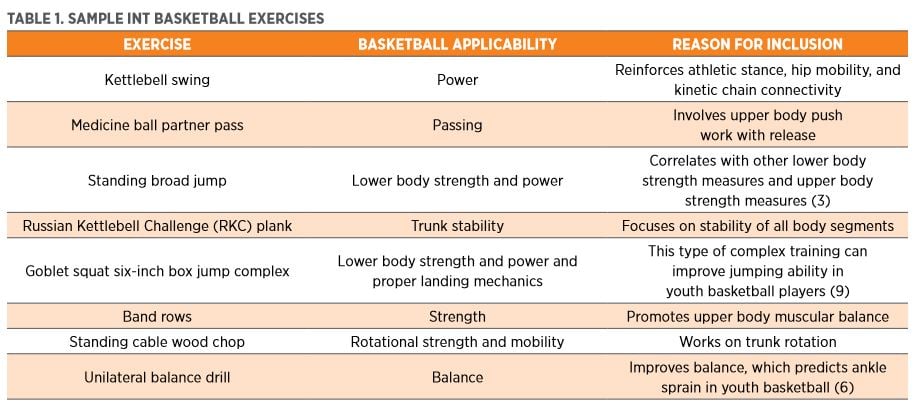Integrative Neuromuscular Training for Youth Basketball Players
by Rick Howard, MEd, CSCS,*D
NSCA Coach
January 2014
Vol 3, Issue 1
Strength and conditioning coaches with knowledge of the exercise principles for youth and the specific demands of basketball can design effective integrative neuromuscular training (INT) programs based on the individual needs of youth athletes.
When creating a strength and conditioning program for athletes of any age, a needs analysis is essential to identify the needs and limitations of the athlete for a particular sport (1). A needs analysis includes all fitness and performance attributes specific to the sport as wells as the psychosocial elements of sport (4). For youth athletes, the focus of strength and conditioning should be on multilateral development, training-age related exercises and drills, and injury prevention through the application of safe and proper technique, rather than the amount of weight lifted (2,4,7).
A needs analysis for basketball reveals that the phosphagen and glycolytic systems are the most dominant, but aerobic metabolism is also involved. Locomotor skills commonly seen in basketball include running, jogging, and submaximal repeated jumping (multiple-effort power) in combination with body awareness skills such as turning, landing, dodging, static and dynamic balance, and agility. Another aspect of the sport involves object control skills for controlling a basketball while dribbling, passing, shooting, rebounding, etc.
To satisfy the needs of strength and conditioning for youth basketball, a multidimensional, comprehensive youth-focused program is recommended. Integrative neuromuscular training (INT) has been shown to be an effective training methodology to improve fitness, promote physical activity, and engage youth in the strength and conditioning process (8). INT includes health fitness (e.g., muscle strength, cardiovascular endurance, muscle endurance, and flexibility), skills fitness (e.g., agility, balance, coordination, speed, power, and reactive ability), and sports fitness (e.g., applied motor skills in a sports context) in a balanced age-related progression. INT has been shown to promote physical literacy and long-term athletic development (5).
Sample INT Exercises for Youth Basketball
It is important to remember that the training age of young athletes needs to be considered when designing the INT program. Each participant should have an individualized program based on their experience with strength and conditioning, not on their age or grade in school. Youth strength and conditioning coaches who work with youth basketball athletes are encouraged to select exercises and drills that are appropriate for their athletes. Table 1 provides several exercises and drills that may be integrated into a youth basketball athlete’s INT program.

Conclusion
Basketball involves health, skills, and sport fitness attributes. INT incorporates, and improves, these attributes and is effective for reducing the risk of injury (5,8). Strength and conditioning coaches with knowledge of the exercise principles for youth and the specific demands of basketball can design effective INT programs based on the individual needs of for youth athletes.
This article originally appeared in NSCA Coach, a quarterly publication for NSCA Members that provides valuable takeaways for every level of strength and conditioning coach. You can find scientifically based articles specific to a wide variety of your athletes’ needs with Nutrition, Programming, and Youth columns. Read more articles from NSCA Coach »
References
1. Baechle, T, and Earle, R, and Wathen, D. Resistance training. In, Baechle, T, and Earle, R. Essentials of Strength Training and Conditioning (3rd ed.) Champaign, IL: Human Kinetics; 382-383, 2008.
2. Bompa, T, and Haff, G. Periodization: Theory and Methodology of Training (5th ed.). Champaign, IL: Human Kinetics; 2009.
3. Castro-Pinero, J, Ortega, F, Artero, E, Girela-Rejon, M, Mora, J, Sjostrom, M, and Ruiz, J. Assessing muscular strength in youth: usefulness of standing long jump as a general index of muscular fitness. The Journal of Strength and Conditioning Research 24(7): 1810-1817, 2010.
4. Lloyd, R, Faigenbaum, A, Stone, M, Oliver, J, Jeffreys, I, and Moody, J. Position statement on youth resistance training: The 2014 international consensus. British Journal of Sports Medicine 48(7): 1-12, 2013.
5. Lloyd, R, Oliver, J, Faigenbaum, A, Howard, R, Ste Croix, M, Williams, C, et al. Long-term athletic development - Part 1: A pathway for all youth. The Journal of Strength and Conditioning Research 29(5): 1439-1450, 2015.
6. McGuine, T, Greene, J, Best, T, and Leverson, G. Balance as a predictor of ankle injuries in high school basketball players. Clinical Journal of Sport Medicine 10(4): 239-244, 2000.
7. Myer, G, Faigenbaum, A, Ford, K, Best, T, Bergeron, M, and Hewitt, T. When to initiate integrative neuromuscular training to reduce sports-related injuries and enhance health in youth? Current Sports Medicine Report 10(3): 155-166, 2011.
8. Naclerio, F, and Faigenbaum, A. Integrative neuromuscular training for youth. Kronos X(I): 49-56, 2011.
9. Santos, E, and Janeira, A. Effects of complex training on explosive strength in adolescent male basketball players. The Journal of Strength and Conditioning Research 22(3): 903-909, 2008.
- Privacy Policy
- Your Privacy Choices
- Terms of Use
- Retraction and Correction Policy
- © 2025 National Strength and Conditioning Association